Royal Naval Auxiliary Service
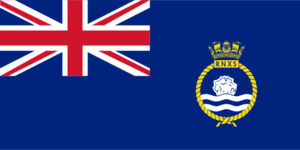 Ensign of the Royal Naval Auxiliary Service.
|
The Royal Naval Auxiliary Service (RNXS) was a uniformed, unarmed, civilian volunteer service, administered and trained by the Royal Navy to operate in the ports and anchorages of the UK in an Emergency. Although the abbreviated title would logically have been RNAS this abbreviation had long been taken by the various Royal Naval Air Stations, so RNXS it was. It maintained training units, and vessels at most major ports in the UK. and was formed in 1963 from the amalgamation[1] of the Royal Naval Mine-watching Service (RNMWS) and Admiralty Ferry Crew Association[2] in response to the perceived nuclear threat to British ports. The service was disbanded on 31 March 1994 due to Ministry of Defence (MOD) cuts.[3] Most vessels from its fleet were transferred to the Royal Navy or sold,[4] with the exception of XSV Loyal Volunteer, she was struck by a RO-RO Ferry while berthed in Ipswich Harbor and was later scrapped.[4]
Role
The Service was divided into 'Afloat' and 'Ashore' sections, The 'Afloat' personnel manned the Service's dedicated ships[4][5] and the 'Ashore' personnel manned the Port Headquarters(PHQ) which were positioned around the UK. The 'Afloat' section contained engineers, seamen and communications personnel, while the 'Ashore' section consisted of communications and plotting staff, later amalgamated into an 'Operations' section. There was an element of cross-fertilization whereby some people of the 'Afloat' section worked in PHQs as communicators, drivers and security staff and some of the 'Ashore' section worked afloat as engineers, seamen, communicators and, indeed, cooks
RNXS personnel, known as auxiliarymen regardless of gender, were to be readily available to assist in the tasks of evacuating major ports and dispatching larger and faster merchant vessels overseas in case of an attack on the UK. Any remaining ships were to be dispersed to safe anchorages along the coasts or at nearby islands. Formation, planning and sailing of convoys were tasks undertaken in the PHQs by RNXS staff working within overall dedicated RNR control during exercises. The Communications personnel operated the Communications Centre connected via teleprinter and, latterly computer, to all UK MOD Communications Nodes and, unassisted, performed these tasks solely within the RNXS structure on behalf of the overall PHQ Command and Naval Officer In Command (NOIC)
For some of these purposes, the RNXS operated a small fleet of inshore vessels. Initially, the vessels were 45 ft and 61.5 feet Motor Fishing Vessels. These smaller boats were soon replaced by 10 Inshore Minesweepers (Ham Class). R.N.X.S. vessel names were prefixed 'XSV' for Auxiliary Service Vessel. The Minesweepers were de-armed and converted to enable larger training crews to be embarked. The 20 mm Oerlikon Cannon or 40mm Bofors guns were removed but the mounts were kept. Over time, the Minesweepers were replaced by Fleet Tenders, the "Loyals".[5][4][6] Most of this class of ships' names were prefixed 'Loyal' apart from XSV Supporter, whose home port was Belfast, and, given Irish political tensions at the time, the prefix "Loyal" was dropped.[7] The RNXS operated 11 Purpose Built Fleet Tenders[7] and various other small craft. In 1990, a specific threat of port attack by subversive and/or Special Forces was identified and to help to counter this threat, the RNXS received 4 of "P2000" fast patrol craft from the 14 built for the Royal Navy[8] And these P2000s are still in service, as commissioned warships at University Royal Naval Units.
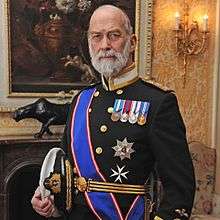
The sailing of merchantmen both overseas and coastal sailings involved setting up assembly anchorages where ships might be formed into convoys, a naval escort or surveillance for information on routing, intelligence, and communications. Auxiliarymen were required at assembly anchorage control to assist in these tasks.[1]
Originally, the Royal Naval Mine-watching Service (RNMWS) had two main tasks in war.[9][10][1]
First, to observe, plot and report the fall of mines laid by enemy aircraft in port approaches and main waterways. Second, to provide the basic local organisation for naval officers in charge at strategic ports Around the UK in war.
These tasks were not new, indeed they had been performed by naval and merchant naval personnel throughout the past centuries. The nuclear threat, however, had cut the time available to the Royal Navy, and the Merchant Navy had to be developed or adapted to cope.
Therefore, the RNXS was formed.[10][3][1]
In 1963 the Royal Mine-watching Service assumed a new role and name with responsibilities to provide staff to support the Navy in the various Ports Headquarters around the UK that would be set up in a National Emergency or war.
Royal warrant
A Royal Warrant was granted changing its name from the "Royal Naval Mine-watching Service" to the "Royal Naval Auxiliary Service" (RNXS) in 1962, to reflect more accurately these new functions.[10]
One of the Royal Navy's major tasks is the protection of shipping, and the RNXS played a non-combatant, but important, role in support of its parent Navy by manning Port headquarters in major ports and anchorages around the United Kingdom. they were to be available to assist in the tasks of evacuating major ports, and dispatching larger and faster merchant vessels overseas in case of an attack on the UK. Any remaining ships were to be dispatched to safe anchorages along the coasts or at nearby islands.
Because merchant vessels would be travelling overseas in time of war, further tasks involved the setting up assembly anchorages, where ships could be formed into convoys ready for a Naval Escort. RNXS personnel were required at these assembly anchorages to assist in routing of vessels, intelligence, and communications both ashore and afloat .The Service also provided craft and crews to support the Navy in these ports and anchorages. These craft ranged from Ex Inshore Minesweepers, Fleet Tenders (Loyal class[6][5][4]) to fast Patrol Boats (P2000 or the shortened P20), permanently on loan to the service. The craft were normally based in Naval Dockyards for the necessary maintenance and technical support from the Royal Maritime Auxiliary service but they were manned entirely by the RNXS crew.
These craft were at sea most weekends for practical training, and also took part in National and NATO exercises, as well as local and out-of-area training cruises. The craft took part in fleet reviews; and have been used in the clearance of oil pollution; search and rescue and many other tasks.
The Ensign of Royal Naval Auxiliary Service
The Ensign was originally created in 1954 for the Royal Naval Mine-watching Service, but when the service was amalgamated with the Admiralty Ferry Crews Association, to become the Royal Naval Auxiliary Service (RNXS) In 1963.[10] The Flag inscription was altered to reflect that name change.
Command Structure[4]
The RNXS command structure[4] was divided in to Geographical Areas within the UK
- Scotland, Northern Ireland & N.E England Training Units[4]
Grimsby,Thorne,Hull,Stockton & Tees-port, Hartlepool, Sunderland, Newcastle, Blyth, Leith, Rosyth, Dundee, Aberdeen, Elgin, Inverness, Inver Gordon, Thurso, Kirkwall, Greenock & Clyde port, Ayr, Bangor, Belfast.
RAF Pitreavie[11]Castle near Dunfermline, Fife, was the Headquarters of the Scotland, Northern Ireland & N.E England, RNXS Group, consisting of both permanent and volunteer staff
- Portsmouth Training Units[4] *
Bexhill, Chatham, Chelmsford, Dover, Felixstowe. Gravesend, Greenwich, Harwich, Isle of white, Ipswich, London, Margate, Poole, Portland, Portsmouth, Sheerness, Shoreham Southampton, Southend, Great Yarmouth.
- Plymouth Training Units[4] *
Exeter, Guernsey, jersey, Torbay, Plymouth, Fowley, Falmouth, Penzance, Barnstable, Bristol, Gloucester, Sully, Swansea, Pembroke Dock, Holyhead, Menai bridge, Conwy, Liverpool, Inskip.
RNXS Crew
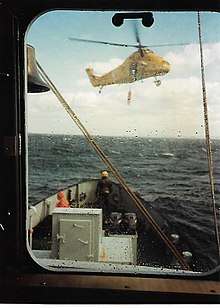
The RNXS accepted women among its crews before the Royal Navy did. The first female skipper was Denise St Aubyn Hubbard in 1978.[1][3]
The men and women of the RNXS, or auxiliary-men as they were known (regardless of gender), were between the ages of 21 and 60 and came from various backgrounds as civilians or Ex service personnel.
Members undertook weekly classroom training, in their chosen departments, Engineering, Seamanship, Communications, and Operations. ashore and afloat, and worked towards qualifications, members also took part in extended formal training with the Navy[4]
The RNXS had a pleasant family flavour and in many units,were husbands and wives, sons and daughters[3] training together for the job best suited to former experience and physical abilities.[3]
The Captains of the RNXS to 1987[1]
November 1963 - December 1966 J.A. Murray
December 1966 - January 1970 D.R. Johnston
January 1970 - February 1973 D.J. Farquharson
February 1973 - March 1976 P.S. Hicks-Beach
March 1976 - August 1979 G.J.M. Andrewes
August 1979 - November 1982 P.R.D. Kimm
November 1982 - November 1984 M.R.Hare
November 1984 - end of period J.R. Griffiths
The Earl Of Mar and Kellie was a member of the RNXS in the 1980s[12]
Those who served in the RNXS were volunteer reservists and are therefore veterans of Her Majesty's Armed Forces and are eligible to receive a Veterans Badge from the UK Ministry of Defence, upon application.[13]
In 1990 the RNXS had a personnel of 3,200.[14]
The day after the Royal Naval Auxiliary Service was disbanded on 31 March 1994, its members formed the Maritime Volunteer Service (MVS)
Vessels
Ham Class Inshore Minesweepers
Of the 93 Ham Class minesweepers built in the 1950s for the RN, and commissioned in 1956 (none of which saw active service) 10 where later allocated in 1964 to the newly formed RNXS
| Name | Call sign | Pennant No | Completed | Builders | Joined RNXS | Disposal |
| Birdham | M.2785 | 5-Mar-57 | J.Taylor | 1964 | May 1980 - Arrived Great Wakering, Essex for Breaking | |
| Odiham | M.2783 | 27-Jul-56 | Vospers | 1964 | 1978 - on disposal list., May 1980 sold to Sutton & Smith, Great Wakering, Essex | |
| Pagham | M.2716 | 22-Mar-56 | Jones, Buckie | 1964 | to 1974.1982, RNR Tender | |
| Portisham | GTDG | M.2781 | 26-Mar-56 | Dorset Yacht | 1964 | to 1983 at HMS Vernon, Portsmouth |
| Puttenham | M.2784 | 9-May-58 | Thorneycroft | 1964 | to 1978 at Plymouth | |
| Saxlingham | M.2727 | 29-Jan-57 | Berthon Boat | 1964 | to 1965. Approved to scrap 1966. 2 May 1968 sold to Ross & Cromarty CC for Lewis Sea School | |
| Shipham | MTMW | M.2726 | 3-Feb-56 | Brooke Marine | 1964 | to 1983 at Gillingham |
| Shrivenham | M.2728 | 11-Aug-56 | Bolson | 1964 | to 1965. For disposal in 1966. Sold to PLA, 21 Feb 1969Approved to scrap 1966. 2 May 1968 sold to Ross & Cromarty CC for Lewis Sea School | |
| Thakeham | GTJC | M.2733 | 15-Nov-57 | Fairlee Yacht | 1964 | to 1978. 1979 for disposal |
| Tongham | M.2735 | 18-Jun-57 | J.Miller | 1964 | to 1978, also PAS. 1979 for disposal |
Loyal class Fleet Tenders[4]
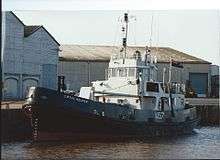
The Loyal class Fleet Tenders were purpose built in the late seventies by Richard Dunston[15][5] of Thorn, South Yorkshire, as training vessels for the RNXS, they were based on a proven MOD/RMAS design for supply tenders
However, in the RNXS version the hold was converted at build stage[5] for extra accommodation for RNXS crew. They had interior hatches down into the converted holds, now fitted with bunks and living quarters. Externally, they are very similar to the "Clovelly class" supply Fleet Tenders.
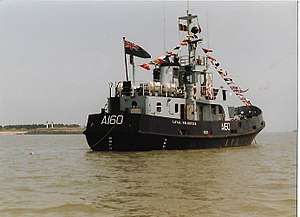
| Name | Pennant number | Notes |
|---|---|---|
| Loyal Helper | A157 | Transferred to RMAS |
| Supporter | A158 | Disposition unknown |
| Loyal Watcher | A159 | Transferred to URNU |
| Loyal Volunteer[4] * | A160 | Struck by RO-RO Ferry whilst berthed in Ipswich harbour; later scrapped[7] |
| Loyal Mediator | A161 | Diving support vessel |
| Loyal Moderator | A220 | Disposition unknown |
| Loyal Factor | A382 | Transferred to HMS Vigilant |
| Loyal Governor | A510 | Transferred to RMAS as RMAS Alert |
| Loyal Chancellor | A1770 | Transferred to URNU`s** |
| Loyal Proctor | A1771 | Disposition unknown |
*Because of its name Loyal Volunteer was generally considered the flagship of the RNXS
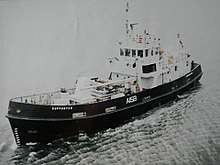
** University Royal Naval Unit (URNU)
Archer class (P2000 or "P20")
| Royal Navy | |||||
|---|---|---|---|---|---|
| Name | Pennant number | Builder | Commissioned | Attached to | Status |
| Example (ex-XSV Example)[4] | P165 (ex-A153) | Watercraft Marine | 1985 | Northumbrian URNU | In active service |
| Explorer (ex-XSV Explorer)[4] | P164(ex-A154) | Watercraft Marine | 1986 | Yorkshire URNU | In active service |
| Express (ex-XSV Express)[4] | P163 (ex-A163) | Vosper Thornycroft | 1988 | Wales URNU | In active service |
| Exploit (ex-XSV Exploit)[4] | P167 (ex-A167) | Vosper Thornycroft | 1988 | Birmingham URNU | In active service |
Following the disbandment of the RNXS, the Loyal Class fleet tenders and the P2000 were sold or reassigned within the Royal Navy[4]
Disbandment
On 18 October 1993 Malcolm Rifkind (Secretary of State For Defence 1992-1995) announced in the House of Commons that proposals[16] set out in June regarding the future of the Royal Naval Auxiliary Service and Royal Auxiliary Air Force had been confirmed, and as no role could be found for them they would be disbanded[17] the following year.[10]
On 18 February 1994 it was confirmed in the House of Commons as part of that same review that there was no continuing defence role for the Royal Naval Auxiliary Service, and after a properly managed rundown the RNXS would disband from 31 March 1994.[18]
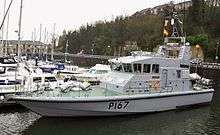
A serious machinery space fire occurred on XSV Exploit[7] approximately 30 miles of Lundy island, at 0645 19 March 1994, as she was being transferred to RN Portsmouth from Greenock as part of the managed run down of the service by RNXS crew.
The Padstow lifeboat and the RAF SAR Helicopter from Chivenor, were scrambled, and a tanker en route to Milford Haven was diverted to help, but they were not needed. If not for the coolness, professionalism, and bravery of the RNXS skipper Area Officer K Warner (Thorne unit),[7] Charge Engineer Area Officer G Swan (Hartlepool unit),[4] and Mate, J Smith (Rosyth unit),[7] who entered the compartment 3 times in breathing masks when the Halon drenching[19] system failed, to fight the fire with fire extinguishers,[7] the ship, and quite possibly lives, would have been lost.[7]
The fire was later attributed to a major mechanical failure of the starboard main engine,[4] resulting in a large hole in the sump casing.[4] The fire spread quickly to the air ducts, igniting various rubber coolant pipes causing thick acrid, toxic smoke.[7]
The mood in the service was further compounded with the loss of Loyal Volunteer, in Ipswich harbour[7] later that year, and was seen as a sad end to a faithful vessel, and Aux Lt Cdr R.A Hare noted,[7] "That this should be the fate of Loyal Volunteer, was not without its significance".
Not all of the members of the RNXS were lost for good when the RNXS disbanded. Some 2,000 former members of the RNR and RNXS formed the Maritime Volunteer Service, a civilian but uniformed organisation,[20] as a national maritime training organisation, with charitable status. Designed to perpetuate maritime skills, in order to continue and develop those skills it has taken over and expanded many RNXS roles.[20] The Maritime Volunteer Service has recently been officially recognised by the Royal Navy.
See also
- Royal Naval Reserve (RNR)
- Maritime Volunteer Service(MVS)
References
- 1 2 3 4 5 6 John, Murry (2 May 1988). Royal Naval Auxiliary Service. Maritime Books. ISBN 0907771378.
- ↑
- 1 2 3 4 5 Stanley, Jo (2016). From Cabin 'Boys' to Captains: 250 Years of Women at Sea. The History Press. p. Appendix 4. ISBN 9780750968775.
- 1 2 3 4 5 6 7 8 9 10 11 12 13 14 15 16 17 18 19 20 21 "The Volunteer". The Volunteer". The Volunteer (the final journal of the royal naval auxiliary service) Published March 1994,Holbrook printers,Portsmouth. March 1994.
- 1 2 3 4 5 "The National Archives-Richard Dunston Ltd". 1913–1970.
- 1 2 "Fleet Tender Information".
- 1 2 3 4 5 6 7 8 9 10 11 "The Volunteer". The Volunteer (the final journal of the royal naval auxiliary service) Published March 1994,Holbrook printers, Portsmouth. March 1994.
- ↑ "Navy News". Navy News, The online version of the official newspaper of the Royal Navy. 199405.
- ↑ http://hansard.millbanksystems.com/written_answers/1961/jul/05/royal-naval-minewatching-service#S5CV0643P0_19610705_CWA_26
- 1 2 3 4 5 "Hansard the Official Report report of proceedings of both the House of Commons and the House of Lords".
- ↑ Nelson, Andrew. Pitreavie Castle, History and Legend . www.maclean.com.
- ↑ Westminster, Department of the Official Report (Hansard), House of Lords,. "Lords Hansard text for 14 Jan 2004 (240114-16)". www.publications.parliament.uk. Retrieved 2017-06-27.
- ↑ "Veterans Eligibility". UK Government.
- ↑ Paxton, J., ed. (1990). The Statesman's Year-Book 1990-91 (127th ed.). The Macmillan Press. p. 1315. ISBN 9780230271197.
- ↑ "Doncaster Archives". The Local Studies Library collects and preserves historical and contemporary information relating to the Metropolitan Borough of Doncaster,.
- ↑ https://archive.org/stream/op1279374-1001/op1279374-1001_djvu.txt
- ↑ http://hansard.millbanksystems.com/commons/1993/oct/18/statement-on-the-defence-estimates#column_39
- ↑ http://hansard.millbanksystems.com/written_answers/1994/feb/18/royal-naval-auxiliary-service#S6CV0237P0_19940218_CWA_330
- ↑ "Gaseous_fire_suppression".
- 1 2 "Select Committee on Defence Eighth Report". Parliament UK.
